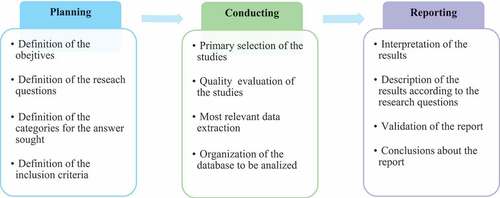Abstract
In the present digital age, students and professionals can interact and collaborate anywhere in the world through multiple means of communication. This article analyzes the scientific evidence of intercultural competencies in higher education from January 2016 to August 2021 out of the publications available in the Web of Science and Scopus databases. Inclusion and exclusion criteria resulted in 325 articles being selected for review. The findings denote the relevance of this thematic area in teaching language, international experiences, virtuality, and collaborative learning. The approach with the highest incidence was qualitative research for case study designs, and the research trends proposed by the authors highlight intercultural education and virtual interaction to support global collaboration. The present work describes the studies carried out in this field in the last six years and aims to be valuable for future research related to educational innovation, the development of intercultural competencies, and international cooperation.
Public interest statement
Nowadays, students and professionals can interact and collaborate anywhere in the world through multiple means of communication. Intercultural competencies are defined as adequate and relevant knowledge about particular cultures, integrating a range of complex contextual knowledge, which are essential to develop in order to effectively interact and collaborate with individuals from different cultural contexts. This article analyzes 325 articles of the scientific evidence of intercultural competencies in higher education from January 2016 to August 2021. The main findings denote the relevance of this thematic area in teaching language, international experiences, virtuality, and collaborative learning. The research trends proposed by most of the authors highlight intercultural education and virtual interaction to support global collaboration. The present work describes the studies carried out in this field in the last six years and aims to be valuable for future research related to educational innovation, the development of intercultural competencies, and international cooperation.
1. Introduction
Due to the global imperative need to take action for sustainable development, well-being, and prosperity, all members of the United Nations (UN), through the United Nations Educational, Scientific and Cultural Organization (UNESCO), created, adopted, and promoted the 17 Sustainable Development Goals (SDGs) from 2015 to the present. The importance of understanding, contribution, and collaboration among individuals is stated in Goal 17: Partnerships to Achieve Goals (United Nations, Citation2015), calling for strong cooperation among nations worldwide, the only way possible to achieve the goals of this 2030 Agenda (UN General Assembly, Citation2015). This, besides promulgating partnerships to potentiate the mobilization of international resources, highlights the importance of providing access to science, technology, and innovation (Eurostat, Citation2022). Open science promotes the generation and use of resources in social and cultural fields for co-construction by proposing innovative solutions that benefit the public and private sectors (Ramírez & García-Peñalvo, Citation2018). To date, significant collaborations have occurred at the international level. However, there is still a way to go in teaching to raise awareness of shared responsibility and the need to form a global citizenship perspective that encourages voluntary contribution and the initiative to work for shared purposes.
Intercultural competency is not limited to intergroup attitudes but also involves awareness and knowledge of different world views and the capacity for behavioral flexibility to face them (Schwarzenthal et al., Citation2019). Intercultural awareness is a skill that must be continuously developed. It is not a fixed objective to be considered separately. On the contrary, observation, analysis, and comparison are suggested to sensitize the students toward language and culture, teach them to reflect on their different elements, and guide them towards a comparison in which different points of view can be recognized, mediated, and accepted (Szczepaniak-Kozak, Citation2016). Thus, interculturality is not defined solely by the geological dimension but is subject to different variables, such as diversity and the cultural influence of continuous interactions among individuals (González Di Pierro et al., Citation2016). Intercultural competencies integrate a range of complex contextual knowledge. Leeds-Hurwitz points out that intercultural competencies are defined as adequate and relevant knowledge about particular cultures (Leeds-Hurwitz, Citation2017), so it is essential to recognize cultural diversity in its multiple manifestations (García-Peñalvo, Citation2017) and carry out the integral development of intercultural competencies for dialogue and comprehensive, deep interactions among individuals from diverse cultural contexts (Zempter, Citation2018). Three intercultural competencies are key in individual preparation for intercultural collaboration: intercultural communication, which refers to understanding and expressing oneself through various forms of communication in a way that makes sense, not only to the speaker/actor, but also to others (Leeds-Hurwitz, Citation2017); intercultural sensitivity, which focuses specifically on understanding and empathy regarding differences and possible difficulties when interacting with people from various cultures (Swartz et al., Citation2020) and, finally, intercultural responsibility that demands a shared commitment to solidarity, critical cooperation, and respectful dialogue among individuals with different languages, cultures, epistemologies, and ethical principles (Guilherme, (Citation2020), as well as moral choices and values that apply when participating with others in meetings and during any intercultural exchange (Holmes, Citation2011).
The objective of this study was to review the current scientific evidence regarding developing intercultural competencies in higher education to promote professional collaboration. To this end, we conducted a systematic literature mapping of the articles published in the last six years, from January 2016 to August 2021, following each phase comprising this process. The content analysis and results have made it possible to have a broad overview of state of the art on this subject and detect gaps and areas of opportunity for future research on the relevant topics and trends that have not yet been investigated, which can be crucial in the proposal of intercultural training models.
2. Method
In this study, we conducted a systematic literature mapping (SLM), which analyzed the primary studies of the thematic area of specific interest, obtaining evidence on the subject and identifying its possible aspects (Kitchenham, Citation2007). This methodology gave us a view of the available literature in a certain period before carrying out a systematic review of the literature (SLR), in which more inclusion criteria were applied, thus obtaining a more specific database. In a systematic mapping of literature, the same methods of search and data extraction are used as an SLR (Kitchenham et al., Citation2010) to identify, classify, and analyze the selected scientific publications to find gaps in the research of the central study topic (García-González & Ramírez-Montoya, Citation2019a). When carrying out an SLM, it is essential to specify the thematic area to be reviewed critically in detail to propose a timely line of research that allows identifying the gaps in the analyzed studies and the proposed inquiry needs. (García-Peñalvo, Citation2017).
The effectiveness of the systematic review methodology depends on rigorous compliance to each phase of the process. According to Kitchenham, the three stages of a systematic review are planning, reviewing, and reporting (Kitchenham, Citation2007). Based on ideas proposed by some authors in previous systematic literature mapping studies, Figure shows the phases determined for this study and the actions carried out in each (Fernández-Luque et al., Citation2021; García-González & Ramírez-Montoya, Citation2019a; Matsumoto-Royo & Ramírez-Montoya, Citation2019; Montes-Martínez & Ramírez-Montoya, Citation2021).
3. Planning
The first stage of this systematic literature mapping consisted of planning the study. Since the thematic area of interest, “intercultural competencies in higher education”, is relatively recent, no mappings or systematic reviews of literature about it were found; thus, the need to have a broad vision of the subject, formulating specific research questions for the analysis of each study to be included in the SLM. Table shows each of the questions generated with their expected answers.
Table 1. The research questions of the study
To choose the articles that would make up the study, we determined four inclusion criteria: scientific articles written in English or Spanish, articles contained in the Scopus and Web of Sciences databases, articles published from 2016 to August 2021, and articles related to intercultural competencies development and higher education. The exclusion criteria were: duplicated articles and articles that have not been published in high-impact journals. For this SLM, we chose to review the studies published in the last six years to have a database of the most recent scientific production. Considering the quality we desired for the study, we only chose articles published in high-impact journals.
4. Conducting
In the second stage of this study, we searched the articles to be reviewed. Articles were extracted from databases that ensured access to high-impact journals such as Web of Science and Scopus. To identify the most appropriate search terms, we read and analyzed articles related to developing intercultural competencies in higher education beforehand to determine the concepts commonly used in the subject. Thus, the main terms in the article search were: intercultural competency, higher education, and collaboration. The search was refined by limiting categories, subject areas, and language (English and Spanish). In addition, the previously established inclusion criteria were applied for the type of study and the publication time range (from 2016 to August 2021). Table shows the string used for searching in each database.
Table 2. Search strings of the study
After extracting search string results, we imported the articles into a reference management program to begin the database cleanup process. As shown in Figure , the articles with duplicates found in both databases were detected and removed. The inclusion and exclusion criteria were then applied, resulting in 325 articles that met the requirements of this study.
Figure 2. Flow phases of the systematic review (Liberati et al., Citation2009)
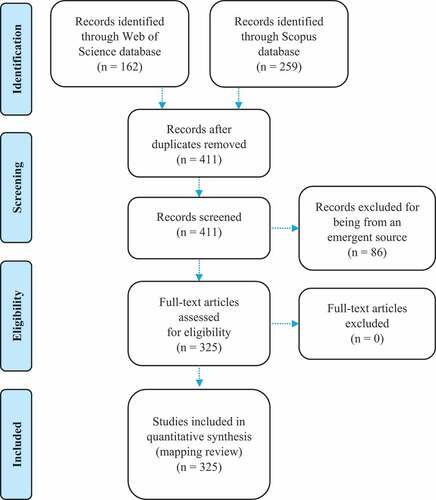
5. Reporting
In the study’s third stage, we analyzed the selected articles, and each of the results was described in detail, answering each research question proposed for this SLM. We validated the report and shared the conclusions on the most relevant findings. The database used for this work is available at: https://doi.org/10.5281/zenodo.6878603.
6. Results
6.1. RQ1: What is the research design of the empirical studies?
Of the 325 articles reviewed in this study, 70 came from Web of Science and 255 from Scopus; a total of 274 empirical and 51 theoretical studies were identified. Of the 274 empirical studies, 152 were qualitative, 66 quantitative, and 56 were mixed methodology (see, Table ). The methodology in each study comprising the SLM database was reviewed, analyzed, and grouped into the three types of research methodologies. The most common qualitative methodological design was case studies with 68%, such as case study [308] analyzing the intercultural competency of teaching English as a foreign language, demonstrating how students who already had such competency engaged in dialogues with students from other cultures more quickly than students without this intercultural competency. Also, case study [160] about the experience of using trans literature to teach intercultural communication highlights the better intercultural understanding of students with this approach.
Table 3. Research design of the studies
Regarding the quantitative method, the most used was experimental design (73%), and the least was Quasi-experimental design (6%). For the studies with mixed methodology, the least used were sequential exploratory design and sequential transformative design (2% each). Very close in percentages were sequential explanatory design and sequential exploratory design, with 50% and 46%, respectively. Among these were interesting studies such as article [7], which investigated the possibility of implementing multidisciplinary and multicultural student teamwork with case-based learning and problem-based learning, and article [111], which examined how online intercultural collaboration improves the integration of technology, intercultural sensitivity, and communication skills in teachers-in-training.
It was possible to identify the opportunity and need for empirical research on this subject using the mixed methodology that combines the perspectives of qualitative and quantitative analyses, which allows identifying the behavior of intercultural competencies in the professional development of university students.
6.2. RQ2: Which intercultural competencies were analyzed in the studies?
As part of the specific analysis in the literature review mentioned in the first section of this study, we identified which of the three major intercultural competency classifications best fit the research reported in each article, either implicitly or explicitly.
The most recurrent competency was intercultural communication (125 studies), explored in topics related to the teaching and learning of languages, specifically English as a foreign language (articles [32] [59] [177] [277] [308]). Independently, 23 studies explored intercultural sensitivity and 8 about intercultural responsibility. 109 of the 325 articles dealt with the three competencies, such as study [95] on developing intercultural competencies in European institutions, article [104] on diagnosing and understanding the perspective of Portuguese scholars regarding the components of intercultural competency, and article [107] that explored the tool of working in intercultural groups as a learning strategy among university students. 53 articles related to communication and sensitivity: the most common themes were collaboration and multiculturalism. Regarding responsibility and sensitivity, there were only 5 and 2 articles, respectively [155] and [174].
This mapping allowed us to visualize the aspects to direct future research efforts to consolidate a complete scenario considering these competencies in university academic development.
6.3. RQ3: What are the main topic areas of the studies?
The thematic area in which intercultural competencies were studied in each article was also identified (Figure ). In the analysis of the development of intercultural competencies to promote collaboration on the pedagogical training question and telecollaboration, study [214] stood out. It analyzed the assumptions and tensions among students during exchanges and international collaboration. Also, article [67] related how it was sought to increase intercultural competency in students by participating in international virtual teams to work on a collaborative project.
Figure 3. Distribution of the specific intercultural competency approaches in the studies
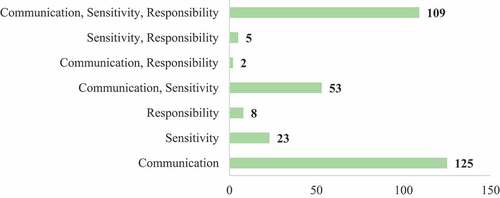
Figure 4. Main topic area addressed in the study context
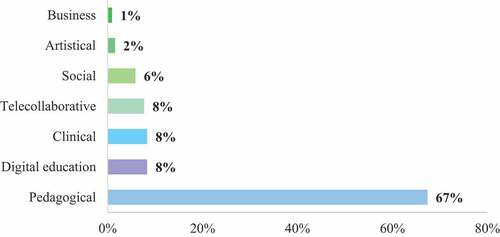
To understand the analysis more profoundly, we established the relationships between the studies’ thematic areas and their distribution per publication year (Figure ).
Figure 5. Main study topics by the year of publication
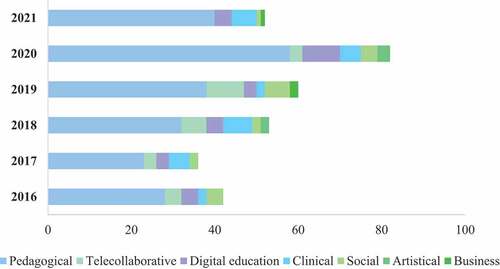
This visualization allowed observing how the main classification of the research topic behaved and the most outstanding topic area in each year analyzed to determine the possible future behavior and intercultural competency research areas in greater need of development. In 2020, it was evident that most publications focused on pedagogy, and you can see the increase in digital education, possibly due to the COVID19 pandemic.
6.4. RQ4: What is the keyword that best describes the case study?
To identify the topics explored in each of the 325 studies, we assigned a keyword that best describes its content based on the interest of this SLM. Language learning was the most recurrent keyword, appearing in 22% of studies, highlighting the learning-teaching of English as a foreign language. Among some studies highlighted in this context is article [256] investigating how teachers in lower-class institutions in rural China collaboratively explore appropriate strategies and resources to cultivate comprehensive English language and intercultural competencies in their university students. Article [59] investigated whether implementing television advertisements with intercultural messages could improve intercultural sensitivity and positively impact the classroom environment in the context of English as a foreign language (EFL) in Iran.
Classifying the different concepts that emerged from the review, we decided to create four categories: Training, Disciplinary, Collective, and Behavioral. Figure shows that with 109 studies, Collective (purple) was the largest group. This category included studies related to multiculturalism and collaborative work. Disciplinary (blue) had 86 studies on specific disciplines, followed by Training (green), with 67 studies related to the training of professional students and 63 studies in Behavioral (cyan), focusing on topics related to individual behavior.
Figure 6. Keywords assigned to the studies
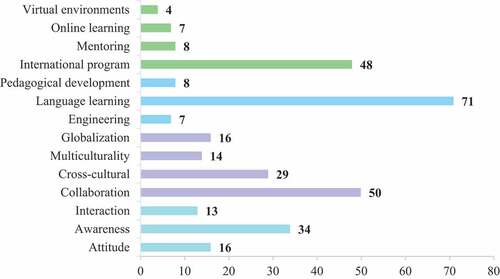
This visualization of the keywords that best describe the studies conducted in the last six years allowed us to identify the key concepts that are part of the theme of developing intercultural competencies in higher education, providing reference guide points to consider future research with a more complete and detailed investigation.
6.5. RQ5: What are the main trends and topics analyzed in each study?
Following the analysis of the studies for gaps in the research theme of this SLM, we identified the main topics and trends in each of the 325 articles. The topics and trends most mentioned and explored in the articles were collaborative learning, intercultural communication competence (ICC), intercultural competencies, internationalization, international experiences, English as a foreign language, and professional development (Figure ).
Figure 7. Trends and study topics
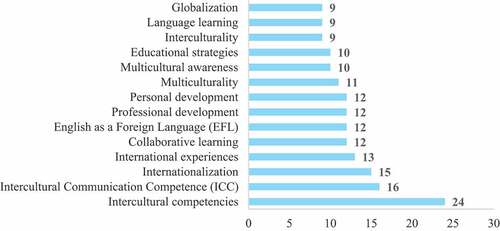
Given the variety of specific concepts in each study and pointing to a broader theme, we could define eight categories to achieve a vision of the areas addressed. 24% of the studies contained a theme related to Interculturality, from intercultural experiences to intercultural learning. An example is study [126] that explores students’ uses and opinions about the design and approach to developing intercultural competencies through an online telecollaboration tool. Another article [313] examines how intercultural communication and the notion of culture are framed in online promotional discourse. In equal percentages (13%) were the categories Internationalization, with articles about international programs, international education, and international academic experiences, and Language, which groups studies on techniques for language learning, in which teaching English language as a foreign language stands out. With 15% each were Culture, containing articles that analyze cultural competency and intelligence, multiculturalism, and cross-cultural learning, and Training, with studies on training and learning strategies. On the other hand: Collaboration (8%) covered topics on collaboration strategies and, mainly, collaborative learning; Virtuality (7%), including content about virtual experiences and work teams; and, finally, the Global group (6%), in which articles dealt with global competition and the path to current globalization.
Knowing the groups of topics and trends addressed in the research allows us to keep in mind what has already been explored and from what perspective it was analyzed to project future studies that combine themes and investigate trends from different angles to have a broader panorama of intercultural competencies in the topics in question ().
6.6. RQ6: What is the most common limitation of the studies?
At 22%, the most recurrent limitation in the studies was the sample size. From the review of the articles, the main limitations that the authors exposed and should be considered in future studies were identified; we grouped them into three categories, as shown in Figure :
Figure 9. The most common study limitations of the studies
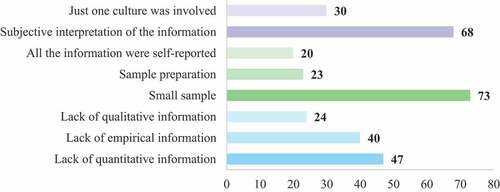
Methodology (blue): In 111 studies, the authors expressed the need to implement some other research method or indicated the lack of information from the methodological research design.
Procedure (green): 116 articles with limitations were identified at the time of the study. These included the sample size, the preparation that could have been given to a large part of the sample, the information collection, and the lack of trustworthy information collected.
Approach (purple): 98 studies in which subjectivity in interpreting the information collected was highlighted, alluding to the influence of who collected the data, especially in studies with a qualitative methodology. Also, in the analysis of intercultural studies, in which it was sought to observe the interaction between cultures, the data collection represented only part of a cultural sample (for example, only one culture was involved).
It is clear that there is a need to investigate this topic with a mixed methodology, allowing qualitative and quantitative information in the results. Also needed are a considerably large sample to achieve a general analysis, avoiding the subjective interpretation of the information collected in each study and involving students from different cultures to investigate the diverse perspectives on intercultural competencies.
6.7. RQ7: What are the possible trends to be analyzed in the future according to the studies?
The most recurrent topic proposed to investigate in the future was intercultural education, such as the study [263] that explores whether undergraduate students in a multilingual and multicultural institution manifested a cross-cultural competency developed during university, and article [265] that investigates whether working in culturally mixed groups can contribute to developing students’ intercultural competency.
Following the line of this work, to define the areas of opportunity to be explored in the subject of interest in developing intercultural competencies in higher education, we established three main categories:
Interculturality: 73% of the studies proposed the need to explore different aspects of topics related to the development of competencies, knowledge, and intercultural training, as well as intercultural experiences. An interesting aspect that emerged during the analysis was the predominant suggestion of intercultural training for professionals in the health sector.
Virtuality: in 16% of the articles, the authors presented the feasibility of deepening the investigation of topics that combine interculturality with digitalization and virtual learning environments.
Collaboration: 11% of the studies, to properly understand and identify the factors that lead to interactions among professional students, mentioned the opportunity to investigate topics on collaborative learning, the means of collaboration, and collaboration at a global level.
Table shows an overview of the thematic trends related to developing intercultural and global competencies in higher education and specific guidelines for researchers’ future studies to contribute knowledge and enrich already known knowledge. These topics were proposed by the various authors of the 325 articles analyzed and determined by the authors of this mapping based on the suggestions and reflections found when reading the studies.
Table 4. Possible trends and topics to be explored
7. Discussion and conclusions
Intercultural competencies and intercultural collaboration in higher education are of great interest to researchers, approaching different aspects with particular perspectives and contexts. Based on Figure , it can be determined that there is a specific need to explore the development of intercultural responsibility competency. Also, intercultural competencies have been chiefly analyzed in the pedagogical context. Moreover, the relevance of this theme is identified in the area of health (Figure ), where studies indicate the opportunity to develop competencies in sensitivity, communication, and intercultural responsibility among health care specialists so that they have better patient interactions, understanding and guiding them, going beyond the language, creating empathy and emotional bonds (Table ). The individual must understand differences and possible difficulties when interacting with people from different countries or cultural contexts (Campbell, Citation2016). This implies that it is essential to consider professional training that provides individual knowledge and global empathy.
Mixed methods allow us to investigate topics from both a quantitative and qualitative perspective. Table shows that a smaller percentage of empirical studies were carried out with a mixed methodology, and a high percentage of the studies in the period analyzed used a qualitative methodology. Figure indicates the limitations identified by the authors who have explored the topic of interest, recognizing the need for attention to the methodology to be implemented and care in managing information and interpreting the information collected. In the mixed methodology, researchers intentionally integrate or combine quantitative and qualitative data instead of keeping them separate. This allows for maximizing the strengths and minimizing the weaknesses of each type of data (Meissner et al., Citationn.d.). The opportunity to investigate intercultural competencies through mixed methods for process depth and constitution due to the findings of empirical studies is then exposed.
Globalization invites us to meet, share and collaborate with people from anywhere in the world, and thanks to technological advances and countless communication tools, this has become possible. Figure shows that language learning has been a leading subject of studies in which the analysis of intercultural competencies has been conducted, explicitly pointing to intercultural communication competency. Intercultural encounters and experiences are prominent in professional collaboration; searching for these encounters is more feasible thanks to growing technological advances, digital media, and virtual environments (Figure ). The principal challenge is to design collaborative learning to facilitate all skills and promote collaboration in digital environments (Kolm et al., Citation2022). The door remains open to focus research efforts investigating intercultural and global competencies integrally through collaborative learning.
The need for international collaboration to develop action plans for solving global problems is imminent. Table shows how 237 of 325 articles proposed investigating some topics related to interculturality, including education, encounters for forming these competencies, and recognizing their importance for promoting intercultural collaboration to attain shared objectives. Intercultural competencies allow the individual to have the proper knowledge and understanding of different cultures and interact and relate effectively in various multicultural environments (Guillén-Yparrea & Ramírez-Montoya, Citation2020). Out of this review, it could be determined that it is still necessary to investigate the subject from a comprehensive perspective, considering the means of communication and the quality of international interaction for teamwork, union, and cooperative search for solutions to global problems.
8. Implications
This systematic literature mapping provides a broad vision of the theme of intercultural and global competencies in higher education and collaboration. Scientific evidence supports the results indicating the research opportunity, from methodological gaps to specific trends, areas of knowledge and development, and relevant concepts to consider for future research and proposals concerning this versatile theme.
As mentioned throughout the study, intercultural competencies enable students to meet with individuals from different cultural contexts, favoring the exchange of ideas, empathy, respect, and effective cooperation when working in multicultural teams. This study allows to visualize in a clear and objective perspective the importance of intercultural competencies in higher education to promote professional collaboration in an international way, pointing out the gaps that exist in the empirical research previously carried out and the tendencies that it is suggested to analyze to formulate better pedagogical and experiential proposals for the development of these competencies in university students. The information shared in this study is therefore of value and notable contribution, not only for those who are already researching this topic, but also for each one of the people who are part of the academic communities that seek to adapt the educational system so that their students are properly prepared for the demands and needs of the actual global world.
9. Limitations and recommendations
A study limitation is that only two databases were consulted, which could have limited the scientific evidence reviewed and restricted the search terms used in each database. It should also be considered that the categories used to group the different topics and trends, and the limitations identified in the studies, were the authors’ decisions.
For future study recommendations, we point out that this article presents a synthesized vision of state of the art in research on intercultural competencies in higher education to encourage professional collaboration. It invites researchers interested in this thematic area to conduct a scientific inquiry into the trends arising from this systematic mapping of literature and the possible aspects not yet explored in their entirety.
Statements and Declarations
The authors declare no potential conflicts of interest concerning the research, authorship, and/or publication of this article.
Acknowledgements
This work was developed with the support of the doctoral program Education in the Knowledge Society, University of Salamanca (García-Peñalvo, Citation2014, Citation2015). We appreciate the facilities provided for its implementation by the managers and tutors who contribute to the training process.
The authors acknowledge the technical support of Writing Lab, Institute for the Future of Education, Tecnologico de Monterrey, Mexico, in the production of this work.
Disclosure statement
No potential conflict of interest was reported by the authors.
Additional information
Funding
Notes on contributors

Nicia Guillén-Yparrea
Nicia Guillén-Yparrea is a professor in the School of Engineering and Sciences, Tecnologico de Monterrey, Mexico, and current student of the doctoral program Education in the Knowledge Society at the University of Salamanca, Spain. She focuses her research on technology for educational innovation, intercultural competencies development and professional collaboration.
María Soledad Ramírez-Montoya
María Soledad Ramírez-Montoya is a researcher in the Institute for the Future of Education, Tecnologico de Monterrey, Mexico. She focuses her activities on the dynamization of initiatives for education, with innovation, research, and global sense, as a means of social transformation and impact for lifelong learning and sustainable development.
References
- Campbell, N. (2016). Ethnocentrism and intercultural willingness to communicate a study of New Zealand management students. Journal of Intercultural Communication English 40 , . https://immi.se/intercultural/nr40/campbell.html
- Eurostat. (2022). Statistics explained: Strengthen the means of implementation and revitalize the global partnership for sustainable development. https://ec.europa.eu/eurostat/statisticsexplained/
- Fernández-Luque, A. M., Ramírez-Montoya, M. S., & Cordón-García, J. A. (2021). Training in digital competencies for health professionals: Systematic mapping (2015-2019). Professional de La Informacion, 30, 2. https://doi.org/10.3145/epi.2021.mar.13
- García-González, A., & Ramírez-Montoya, M. S. (2019a). Systematic mapping of scientific production on open innovation (2015-2018): Opportunities for sustainable training environments. Sustainability (Switzerland), 11(6), MDPI. https://doi.org/10.3390/su11061781
- García-Peñalvo, F. J. (2014). Formación en la sociedad del conocimiento, un programa de doctorado con una perspectiva interdisciplinar. In Teoría de La Educación. Educación y Cultura En La Sociedad de La Información (pp. 15).
- García-Peñalvo, F. J. (2015). Engineering Contributions to a Multicultural Perspective of the Knowledge Society. Revista Iberoamericana de Tecnologias Del Aprendizaje, 10(1), 17–14. https://doi.org/10.1109/RITA.2015.2391371
- García-Peñalvo, F. J. (2017). Mapeos sistemáticos de literatura, revisiones sistemáticas de literatura y benchmarking de programas formativos. https://doi.org/10.5281/zenodo.1067680
- Guilherme, M. (2020). Intercultural Responsibility: Critical Inter-epistemic Dialog and Equity for Sustainable Development, 1–12. https://doi.org/10.1007/978-3-319-71067-9_75-1
- Guillén-Yparrea, N., & Ramírez-Montoya, M. S. (2020). Intercultural and global competencies development to foster professional collaboration among countries: Doctoral thesis research project. International conference on technological ecosystems for enhancing multiculturality (TEEM'20) 10/2020 (ACM). Salamanca, Spain. https://doi.org/10.1145/3434780.3436630 .
- Holmes, P. (2011). Beyond intercultural competence: Intercultural dialogue and responsibility.
- Kitchenham, B. (2007). Guidelines for performing systematic literature reviews in software engineering. https://goo.gl/L1VHcw
- Kitchenham, B., Pretorius, R., Budgen, D., Brereton, O. P., Turner, M., Niazi, M., & Linkman, S. (2010). Systematic literature reviews in software engineering-A tertiary study. Information and Software Technology, 52(8), 792–805. Elsevier BV
- Kolm, A., de Nooijer, J., Vanherle, K., Werkman, A., Wewerka-Kreimel, D., Rachman-Elbaum, S., & van Merriënboer, J. J. G. (2022). International online collaboration competencies in higher education students: A systematic review. Journal of Studies in International Education, 26(2), 183–201. https://doi.org/10.1177/10283153211016272
- Leeds-Hurwitz, W. (2017). Competencias interculturales: Marco conceptual y operativo.
- Liberati, A., Altman, D. G., Tetzlaff, J., Mulrow, C., Gøtzsche, P. C., Ioannidis, J. P. A., Clarke, M., Devereaux, P. J., Kleijnen, J., & Moher, D. (2009). The PRISMA statement for reporting systematic reviews and meta-analyses of studies that evaluate health care interventions: Explanation and elaboration. PLoS Medicine, 6(7), e1000100. https://doi.org/10.1371/journal.pmed.1000100
- Matsumoto-Royo, K., & Ramírez-Montoya, M. S. (2019). Practice-based teacher education: A literature mapping over the past five years. ACM International Conference Proceeding Series, 696–703. https://doi.org/10.1145/3362789.3362791
- Meer, H. I., Creswell, J. W., Klassen, A. C., Clark, V. L. P., & Smith, K. C. (n.d.). Best practices for mixed methods research in the health sciences.
- Montes-Martínez, R., & Ramírez-Montoya, M. S. (2021). Systematic mapping: Educational and social entrepreneurship innovations (2015–2020). Education and Training. Emerald Group Holdings Ltd. https://doi.org/10.1108/ET-04-2021-0133.
- Pierro, G. D., Flores Fahara, C. M., & Focsan, R. (2016). The development of the intercultural competence, through the perspective of the meaningful learning in foreign language teachers. Revista Del Instituto de Estudios En Educación Y Del Instituto de Idiomas Universidad Del Norte, 25. https://doi.org/10.14482/zp.22.5832
- Ramírez, M. S., & García-Peñalvo, F. J. (2018). Co-creation and open innovation: Systematic literature review. Comunicar, 26(54), 9–18. Grupo Comunicar Ediciones
- Schwarzenthal, M., Schachner, M. K., Juang, L., & van de Vijver, F. J. R. (2019). Reaping the benefits of cultural diversity: classroom cultural diversity climate and students’ intercultural competence. European Journal of Social Psychology. https://doi.org/10.1002/ejsp.02617
- Swartz, S., Barbosa, B., & Crawford, I. (2020). Building intercultural competence through virtual team collaboration across global classrooms. Business and Professional Communication Quarterly, 83(1), 57–79. https://doi.org/10.1177/2329490619878834
- Szczepaniak-Kozak, A. (2016). Developing intercultural pragmatic competence in the classroom: Selected theoretical and practical assumptions Interlanguage pragmatics of Poles learning EFL View project RADAR (Anti-Discrimination and Anti-Racism) View project. https://www.researchgate.net/publication/305334077
- UN General Assembly. (2015). Transforming our world: The 2030 agenda for sustainable development. https://www.un.org/ga/search/view_doc.asp?symbol=A/RES/70/1&Lang=E
- United Nations. (2015). Goal 17: Revitalize the global partnership for sustainable development. https://www.un.org/sustainabledevelopment/globalpartnerships/
- Zempter, C. (2018). Intercultural Praxis in Service-Learning Contexts. Western Journal of Communication, 82(5), 575–594. https://doi.org/10.1080/10570314.2017.1416490

